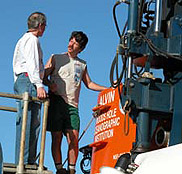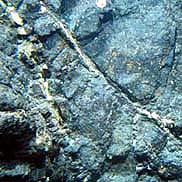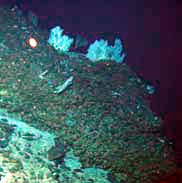|
|
|
|
|
|
|
|
|
| Sun |
Mon |
Tue |
Wed |
Thu |
Fri |
Sat |
|
|
 |
|
Q. What made you decide that you wanted to become a scientist? (Routara W., East Central Middle School, Moss Point, MS)
A. Debbie Kelley answers: I became a scientist because I wanted to understand how our planet works-an innate curiosity in part. In addition, a major thrill and excitement comes from finding out an answer to a puzzle you have been working on for several months, or even maybe years. When all the pieces fit together, for me there is a great satisfaction. Finally, there is always the hope that we will discover a new
|
 |
|
 |
|
|
|
|
|
 |
The second dive of the expedition reminded me of the strengths of diving in Alvin and the appreciation for the scale of the landscape that one can only get by actually being there in person. Our dive began as they all do,with the systematic run through all of the safety checklists, climbingdown into “the ball”, leaving the ship, and descending through the deepening blue into the quiet blackness of the deep sea. It’s a fantastic experience no matter how many times you do it.
Our mission on this dive was to explore more of the seafloor surrounding the hydrothermally active carbonate towers of the Lost City vent field, mapping the geologic features, looking for other sites of venting, and taking as many samples as the sub can hold. Phil Forte is our highly capable and hard-working pilot, geologist Jeff Karson is on the port side, and I am tucked into the starboard side, but we shift around from time to time to share looks out of our three view ports. Since we never get below the thermocline on this dive (the water temperature around the sub stays above 10 degrees Celsius or 50 degrees Fahrenheit), the sub stays comfortably warm throughout the dive.We touch down at a depth of 870 meters, about 300 meters west of the known warm vents. We are on the side of a steep undersea
 |
|
BLee Williams (right), Alvin's Chief Pilot, gives Dave Butterfield last-minute instructions before Dive 3863 begins.
|
 |
mountain, and the terrain is extremely rugged and dramatic. We drive the submarine to the north up the steep slope, covered with debris sliding down from above, including some curiously uniform brown twig-like pieces that we are not equipped to sample, and quickly arrive at the base of a near-vertical cliff. The pilot adjusts the ballast and we begin ascending up the face of the cliff, noting changes in color, texture, and fabric in the rock. We go up and down the face of this cliff several times during the dive as we make our way from west to east. In many places that I have been in Alvin, I have so wished that the mile or more of ocean water could be removed so I could walk around to explore the terrain, but not today. Flying and hovering in Alvin is a fantastic way to view features that would require pretty serious mountaineering skills to see on dry land.
 |
|
Whitish veins in the cliff face indicate past hydrothermal alteration.
|
White features in the dark rock background are signs of potential hydrothermal activity. We investigate many white carbonate veins and small chimney growths in our traverse. In one promising case, we followed delicate carbonate growths up along cracks in the cliff face, ending in an extensive area of bright white carbonate (which we believe to be recently formed) beneath an overhanging ledge of older cemented carbonate breccia. We examined these as closely as we could, and could not find any sign of actively flowing fluids forming these features. Apparently the flow rates here are as slow as the gradual dripping that forms more familiar stalactites in limestone caves, and we will not be able to sample the fluids. We do, however, bring back a sample of a small carbonate chimney growing out of the side of the cliff.
 |
|
Corals grow atop a broken block of breccia at the top of Atlantis Massif.
|
 |
After exploring and sampling a variety of rocks for six hours, we are running short on time and power, so we drive straight to the gigantic Poseidon carbonate tower to sample fluids and biota. I have heard how big this feature is, but I am still amazed when I see it. We start somewhere near the base of this massive carbonate tower and follow it up 40 meters to the top. We quickly fill all of the water samples at a small vent and collect swarming amphipods and other small swimmers that seem to gather around the heat of the sub lights in the “slurp” sampler (basically an underwater shop vac).
Getting my first view of this area focuses my attention on the question of what controls the location and rate of formation of these giant carbonate chimneys. With a trickle of warm fluid venting at the top of a small mountain of carbonate, and no apparent fluid venting from the small features growing on the cliff face, these are clearly slowly-forming structures. This expedition has just gotten started, and we hope to understand much more before it is finished.




